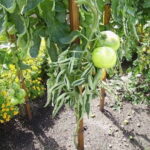Often when you grow your own plants, they get a bit tall because home gardeners don’t have the same growing conditions greenhouse operators have. If your plants are tall at transplanting time, don’t worry about it. Set them in deeper. We’ve seen many old time gardeners; take tall leggy plants and set them in with a crow bar. A better method is to dig a shallow ditch and lay the stems in it, water them well, and cover with soil.
Roots form tip and down the stem. If tomato plants are short and stocky at transplanting time don’t let their size fool you. They-will catch up with the taller plants and you’ll find they’ll both bear about the same time. Potted tomatoes, those started indoors in individual pots, will usually bear earlier because they have blossoms, buds and even small fruits at setting out time.
Remember, varieties make the difference in time of fruiting. For example, Valiant or Fireball will bear a lot earlier than Rutgers or some other later type. Incidentally, if you had tomato horn worm last year, try this trick: I place moth balls, in the soil around our newly set tomato plants, and it does a great job in preventing the tomato hornworm.
Mountain Ash Made to Bear
Got a Mountain Ash tree which will not bear? Try this trick: I had a Mountain Ash tree 15 years and it never had a blossom on it. An old time nurseryman told me a trick mentioned in a book on fruits and vegetables. He said to take a real sharp knife and cut around the trunk of the tree in the spring. After that the, tree was so loaded with berries we had to brace the branches up. I made the cut around the tree where the branches start, and I cut real deep. I even made jelly from the berries! Note: Ringing is a trick many use; to induce a tree to bear.
About June 15, a slash is made around the trunk, cutting through the bark. Some growers make a ½ inch cut and remove this section from the trunk of a tree. After the ½ -inch ring of bark is removed the wound is covered with tape to prevent drying. The removal of this ring of bark, prevents the food materials made by the leaves from traveling to the roots. Simply scoring the bark around the trunk with a knife is as effective as removing a section of bark, and it’s a lot safer. Age of the tree is a factor in bearing. Takes anywhere from six to 10 years for a Mountain Ash tree to bear. Only one tree is needed as each has male and female flowers.
Square Tomatoes on Level?
Last year we grew some tomatoes which produced fruit that was almost square instead of round. No one has heard of such a thing and I can’t locate any plants. Ever hear of it? Yes, there is such a thing as a “square” tomato. Hybridizers have developed a tomato with a shape that could be called “blocky.” rather than “square.” It is not really a matter of great importance to the home gardener since the whole idea is to make the square fruit fit better in a carton. A good deal of work is being done on this in California where the chief idea is to develop varieties that. are better adapted to mechanical harvest and to shipping. Meanwhile, better stick to the “round” tomatoes because we’ve got some varieties you can’t beat, for flavor and shape.
When Will Shrubs Bud Out?
Many home gardeners who planted dormant nursery stock such as roses, fruit trees and shrubs have wondered when their plants will start to bud out? They ask: How can we tell if they’re dead? Some of these items will fool you. For example, a locust can take as much as six months before buds start to break. Many newly planted fruit trees do the same ting, while others will start to send out new shoots within several weeks. One way to break the dormancy of nursery stock is to prune the tops back a third .at planting time.
If you set our fruit trees, shade trees and shrubs and did not prune the tops back, do so now, as it stimulates the plant and helps to break the dormancy. You can tell if your plants are alive or not by using the fingernail test. Skin back a portion of the bark, and if it looks green, and moist underneath the plant is alive and should grow for you. Or test by breaking off a piece of a shoot. If it snaps with a dry crackle, chances are the plant is dead.
Tomato Plant Varieties



